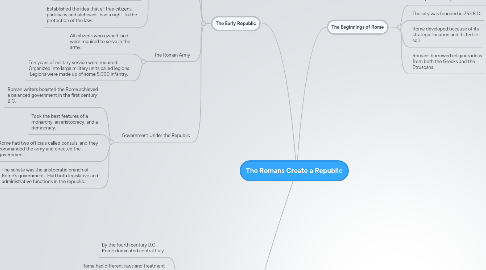
1. The Beginnings of Rome
1.1. The three groups that inhabited the region and eventually battled for control were the Latins, the Greeks, and the Etruscans.
1.2. The city was founded in 753 B.C.
1.3. Rome developed because of its strategic location and its fertile soil.
1.4. Romans borrowed religious ideas from both the Greeks and the Etruscans.
2. Rome Speads Its Power
2.1. Rome Conquers Italy
2.1.1. By the fourth century B.C., Rome dominated central Italy.
2.1.2. Rome had different laws and treatment for different parts of its conquered territory.
2.1.3. For the 250 years after 265 B.C., Roman power spread far beyond Italy.
2.2. Rome's commercial Network
2.2.1. Location gave it easy access to the riches of the lands ringing the Mediterranean Sea.
2.2.2. Traded Roman wine and olive oil for a variety of foods, raw material, and manufactured goods from other lands.
2.2.3. Dominant city was Carthage. Located on a peninsula on the North African coast. Eventually Rome and Carthage fought for control of the Mediterranean.
2.3. War with Carthage
2.3.1. The three Punic wars started in 264 B.C.
2.3.2. The first was for control of Sicily, and the western mediterrranean.
2.3.3. The second Punic war was against Hannibal.
2.3.4. By the third Punic war, Carthage was no longer a threat to Rome.
2.4. Rome Controls the Mediterranean
2.4.1. Romans went on to conquer the eastern half.
2.4.2. Rome took control of Macedonia, Greece, and parts of Anatolia.
3. The Early Republic
3.1. Patricians and Plebeians
3.1.1. The Patricians were aristocratic landowners who held most of the power.
3.1.2. The Plebeians were common farmers, artisans, and merchants who made up the majority of the population.
3.1.3. The senate allowed them to form their own assembly and elect represnatives called tribunes.
3.2. Twelve Tables
3.2.1. Wanted to force the creation of a written law code.
3.2.2. Since the laws were not written down, officials would interpret laws to suit themselves.
3.2.3. The laws were carved on twelve tables.
3.2.4. Established the idea that all free citizens, particians and plebeians, had a right to the protection of the law.
3.3. The Roman Army
3.3.1. All citizens who owned land were required to serve in the army.
3.3.2. Ten years of military service were required. Organized into large military units called legions. Legions were made up of some 5,000 infantry.
3.4. Government Under the Republic
3.4.1. Roman writers boasted the Rome achieved a balanced government in the first century B.C.
3.4.2. Took the best features of a monarchy, an aristocracy, and a democracy.
3.4.3. Rome had two officials called consuls, and they commanded the army and directed the government.
3.4.4. The senate was the aristocratic branch of Rome's government. Had both legislative and administrative functions in the republic.
